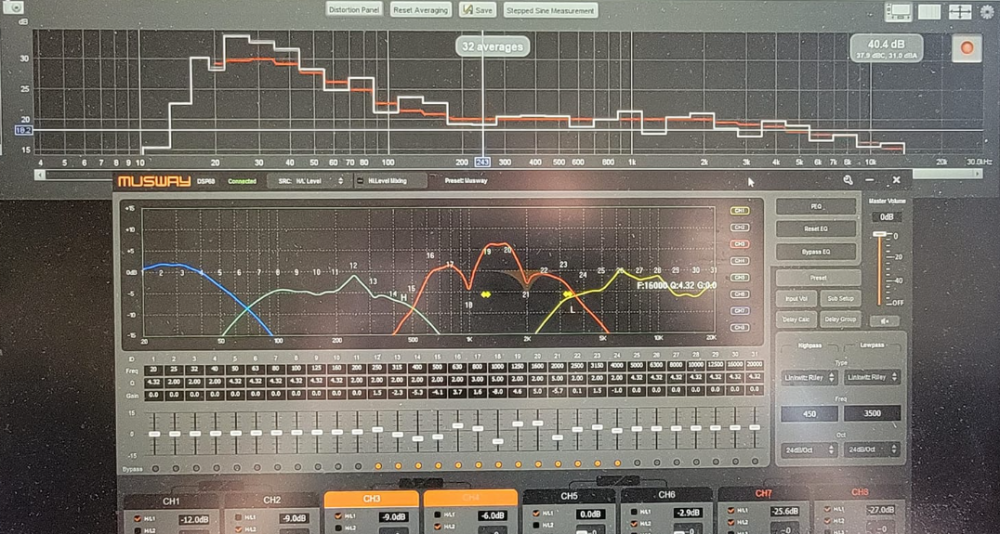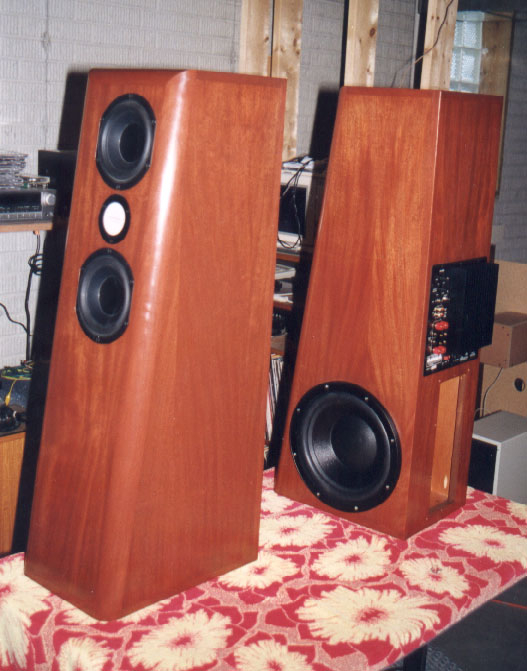Site Links
Howdy, Stranger!
It looks like you're new here. If you want to get involved, click one of these buttons!
Quick Links
Categories
In this Discussion
Who's Online (0)
Available DSP Controllers . . . (FYI post)
I am seeking another 8 channel DSP controller for my shop test rig in speaker building and have come across 2 potential candidates that are more affordable and as good or better than the MiniDSP Flex8:
1). https://www.esxaudio.de/english/d68sp.html
GUI is clunky/cartoonish w/multiple screens/unintuitive/annoying but usable, single 32bit AD1452 DSP chip, 32bit A/D - D/A
$395 delivered from Germany. --> https://masori.de/en/collections/esx/products/direction-d68sp
2). https://muswayusa.com/Product/DSP68
GUI is top notch, Uses (2) 32bit AD1452 DSP chips, 24bit A/D - D/A
$347 delivered from Germany. --> https://masori.de/en/products/dsp68?variant=42383096348926
Neither unit has USB audio input but do have a TOSlink SpDif digital input which will accept a USB audio converter like this --> https://www.amazon.com/Cubilux-TOSLINK-Converter-Compatible-Computer/dp/B0B2DBGKL3/ref=sr_1_1_sspa?keywords=usb+to+toslink&sr=8-1-spons&sp_csd=d2lkZ2V0TmFtZT1zcF9hdGY&th=1
Both have 6 or 8 Analog inputs and 8 Analog outs.
They both have Parametric EQ of 31 bands per channel which far exceeds that of the MiniDSP units.
Trying to decide as I am leaning toward the Musway because it is a more refined version of the ESX with an internal fuse, nicer enclosure, dual 32bit AD1452 DSP's and a very good GUI.
The MiniDSP Flex8 is just too expensive for my needs at $629 delivered with features I will not use.

Comments
Well, the Flex-8 is pretty expensive but not all that much more than an 8-channel DAC like the Topping DM7 that has no DSP at all and cannot operate standalone.
One thing I would consider is the resale potential. The names of these other companies are not well known, so trying to sell the unit if you do not like it will be difficult and/or you many need to sell it for much less than the purchase price. I would expect the MiniDSP to hold its value better.
I really think I should buy for me and not someone else.
It's a shop tool and I'll use it until it goes in the trash or given away as part of an awesome stereo system.
Hey Steve! Nice finds. Which one do will you go with?
I’d recommend the one with a good user interface. But also some support from other users.
Would you consider asking the manufacturer to ship it to Erins Audio Corner for measurements on his shiny new Audio Precision and an accompanying YouTube review? He’s got 35K followers now, and previously a car audio nut, so I think this product might get some interest by his Youtube audience. I don’t think he’s far from you.
Well, everywhere is close compared to OzStraya
Our audionut friend Mark K recently came out of audio retirement and sent his miniDSP C-DSP 8x12 V2.0 in for a measurement to see how this car audio DSP might function in a home hifi/theatre setting.
Even more expensive than Flex 8; but maybe worthwhile if you need 12 outputs-
https://www.audiosciencereview.com/forum/index.php?threads/minidsp-c-dsp-8x12-v2-0-review.44742/
Cool, TKtran!
I pulled the trigger on the Musway DSP68 today and it should show up in a week or so . . .
I'm not really interested in having it analyzed - I just want to use it for testing and development of speaker driver combo's for my personal use.
After reading up on A/D-D/A chips and DSP processing it looks like Musway focused on all the right parts selections so that sealed the deal for me over the ESX unit.
.
I looked online- 350 Euro.
Once it arrives let us know how you like it!
Will do!
It was $347 USD delivered to my door.
I have a drawer full of wall-wart power supplies and found a Kenwood 12vdc 2 amp unit in there and that should be sufficient to run this thing - if not I still have the 12vdc 5 amp Zener diode regulated power supply I built in high school too.
So I downloaded the software from Musway, which covers all their DSPs (I think).
Nice all in one screen UI. I like the click drag and drop feature for PEQs.
On the downside I can't see any biquads, but this is probably not a deal breaker since there are an incredible 31 PEQs to play with.
But the time delay is a little coarse for my liking- (0.02ms or 7mm steps).
Finally it doesn't do high or low shelf filters, and FIR, which is useful for baffle step compensation and bass/treble boost/cut and adjusting phase respectively.
@charlielaub
How does Steve approximate shelf filters using PEQs and standard LR/Bessel/Butterworth filters?
TK - I have no interest in BiQuads. (You really have to geek-out to get into that level of perfection/overthinking it).
The delay resolution stuff is only an issue for a listening room application in VERY near-field monitoring IMHO.
Concerning the --> "Finally it doesn't do high or low shelf filters, and FIR, which is useful for baffle step compensation and bass/treble boost/cut and adjusting phase respectively" <-- I have yet to need any of that stuff using the MiniDSP 4x10HD in near-field/studio use other than the phase reversal which the Musway unit DOES have.
I bought it because it meets my needs but does not exceed them and I saved enough money this month [as a result] to buy 4 new Yamaha XP-70 drum pads [Nice play-ability upgrade over my existing TP-65 pads] as well as the 2 Crestron amps.
I'm all ears concerning the --> "How does Steve approximate shelf filters using PEQs and standard LR/Bessel/Butterworth filters?"
YMMV.
A biquad is just the mathematical name for the "block" of processing that can represent a first or second order filter.
Many of these hardware DSP units give you some preset filter options. This might be Butterworth and LR up to 8th order or whatever. You can control the corner/crossover frequency but you do not get adjustable Q. If your favorite filter is not listed you are out of luck. The only exception to this that I have seen is miniDSP's "advanced biquad" feature.
Anyway, with some filters and PEQ you can get er dun. It's not really precise, but it will probably works for most speaker projects.
FYI - each of the 31 PEQ's per channel have an adjustable Q . . .
Well I hope so! Wouldn't be much of a PEQ if the Q was not adjustable!!!
I was talking about the Q of the filter stages, the biquads. Are those adjustable in this unit?
Filters = BW, LR & Bessel - fixed slopes from 6 to 48 db/oct - I don't recall the MiniDSP having any Q settings for those either unless you create your own filter using BiQuads as you suggest - this thing does not offer BiQuads as of now.
Maybe we should wait until I get it and figure it out more closely on a 3 or 4 way project.
I have some cabinets I have cut out test mountings for a 3 way I can assemble and see what I like or don't about the Musway DSP.
Added 7-18-2023 -->

There's a spread sheet available to calculate biquads to create a Linkwitz transform for the MiniDSP. I've used it and it wasn't all that hard to do.
Ron
Any pointers to this spreadsheet, Ron?
Isn't the Linkwitz transform used primarily for subwoofers?
Something to do with phase correction?
Ok - I found this data to search --> https://duckduckgo.com/?q=linkwitz+transform+spreadsheet+fo+MiniDSP&atb=v357-1&ia=web
Interesting . . .
I'd meant to copy a link. A Linkwitz transform lets you take the response and Q of a woofer system and create a filter to get the response and Q you would like. I used it on an active system where the WAF required a sealed box that was half the size of the box I wanted. I built it for a friend who was an architect and he built a model of the box I proposed from cardboard. His wife said if the speaker was that big she would bury him in it. I originally custom built an analog version of the LT and a few years ago replaced all the electronics after 20 years of use.
https://minidsp.com/applications/advanced-tools/linkwitz-transform
Open the spread sheet and click on the LT tab at the bottom. Fill in the blanks with what you measured nearfield and fill in the F3 and Q you would like to have. It will graph the original response, the new response and the filter response and give you the biquad values to program the miniDSP with.
They're more than 20 years old and still sound great.

Here's a link to an analog version of the LT with a good explanation of what it does.
Ron
Thanks for the LWT link, Ron - very well layed out explanation and data.
Did you mean to add a link for the Analog LWT picture you posted?
Yes I did. I was in a hurry for a dinner date and missed it.
https://sound-au.com/linkwitz-transform.htm
Ron
You certainly do not disappoint, Sir - Thanks again.
Happy listening/experimentation to you.
LWT looks like another "tool" in the sound shaping arsenal but in no-way the only process to achieve the end result.
Your room is going to dictate the approach and experimentation is the only way (IMO) to figure it out.
WW1 and golf have a lot in common with this subject . . .
"His wife said if the speaker was that big she would bury him in it. "
I love it !!! Too funny !!
Does anyone know how much a casket costs??!!
Let's just say, you may as well send yourself to the sky in your dream speakers.
Musway unit finally showed up today.
I have high expectations from this unit based upon its tuxedo-like packaging and the chassis just smacks of quality - solid heavy and well finished.
The presentation is top notch - I hope it lives up to its looks, sound-wise . . . More later . . .